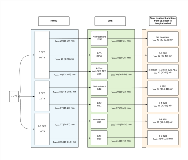Prehospital Pediatric Convulsive Status Epilepticus Care Often Falls Short of Guideline Recommendations (the pSERG Cohort)
Abstract number :
1.235
Submission category :
4. Clinical Epilepsy / 4C. Clinical Treatments
Year :
2018
Submission ID :
501113
Source :
www.aesnet.org
Presentation date :
12/1/2018 6:00:00 PM
Published date :
Nov 5, 2018, 18:00 PM
Authors :
Marta Amengual Gual, Boston Children’s Hospital, Harvard Medical School; Iván Sánchez Fernández, Boston Children’s Hospital, Harvard Medical School; Hospital Sant Joan de Déu, Universidad de Barcelona; Alejandra Vasquez, B
Rationale: The observed time to treatment in status epilepticus (SE) is longer than suggested by guidelines. Delays in treatment may be associated with increased morbidity and mortality. Deviations from guideline-recommended timelines occur often prior to hospital arrival. The objective of this study is to describe the prehospital management of pediatric refractory convulsive SE (rSE) at home and by emergency medical services (EMS). Methods: This prospective observational multicenter study was performed at 12 hospitals within the pSERG cohort from June 2011 to February 2018. We included: a) patients from 1 month to 21 years of age; b) rSE, defined as ongoing SE after at least two anti-seizure medications (ASM), including at least one non-benzodiazepine ASM (non-BZD ASM), or the use of continuous infusion (CI); c) convulsive seizures at onset; d) SE onset outside the hospital; e) use of EMS as means of transport from the prehospital to hospital setting. Exclusion criteria were: a) non-convulsive SE at diagnosis; b) unknown time from SE onset to EMS arrival and hospital arrival. We describe home and EMS treatment, time from SE onset to EMS arrival (Thome), time spent with EMS (Tems) outside the hospital, and time from SE onset to hospital arrival (Ttotal) expressed as median (p25-p75) in minutes. Results: We studied 78 patients (54% males) with a median (p25-p75) age of 3.1 (1.3 – 8.8) years. Etiology of SE was unknown (46%), structural (24%), genetic (8%), metabolic (7%), and others (15%). 12% of patients presented with new onset refractory SE (NORSE). 51% of patients had epilepsy, and 21% had previous SE. SE was intermittent in 67% of patients.56 patients (72%, 56/78) did not receive any BZD at home, including 20 (36%) epilepsy patients, and 4 (7%) with prior SE. Among these 56 patients, 20 (36%) did not receive any ASM by EMS, 33 (59%) received only BZDs by EMS, and 3 (5%) received BZDs and non-BZD ASMs by EMS (Figure1).12 patients (15%, 12/78) received 1 dose of BZD at home. Of those, 3 (25%) did not receive any ASM by EMS, and 9 (75%) received only BZDs by EMS (Figure1).10 patients (13%, 10/78) received 2-3 doses of BZDs at home. Of those, 4 (40%) did not receive any ASM by EMS, and 6 (60%) received only BZDs by EMS (Figure1).The times (Thome, Tems, Ttotal) and the number of BZDs received prior to hospital arrival (expressed as minimum and maximum number of doses administered) are detailed in Figure 1. The median of Ttotal was longer than 30 minutes. 20 (26%) patients did not receive any ASM before hospital arrival, 55 (70%) received 1-5 doses of BZDs, and only 3 (4%) received BZDs and non-BZD ASMs. Conclusions: Prehospital management of SE deviates from guideline-recommended timely ASM administration and escalation (recommended time frames: 1st -2nd BZD 5-10 min; 1st non-BZD ASM 10-20 min; 2nd non-BZD ASM 20-30 min; CI 30-70 min). Tailored interventions may help shorten treatment times. Funding: Pediatric Epilepsy Research Foundation and Epilepsy Research FundMAG is funded by Fundación Alfonso Martín Escudero.
